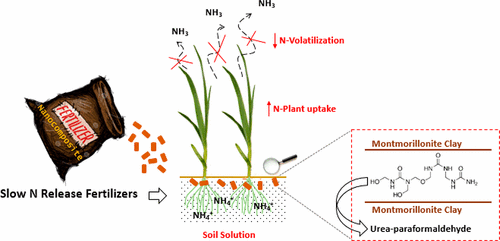当前位置:
X-MOL 学术
›
ACS Sustain. Chem. Eng.
›
论文详情
Our official English website, www.x-mol.net, welcomes your
feedback! (Note: you will need to create a separate account there.)
Controlled Urea Release Employing Nanocomposites Increases the Efficiency of Nitrogen Use by Forage
ACS Sustainable Chemistry & Engineering ( IF 7.1 ) Pub Date : 2017-09-25 00:00:00 , DOI: 10.1021/acssuschemeng.7b01919 Elaine I. Pereira 1 , Ana Rita A. Nogueira 1 , Camila C. T. Cruz 2, 3 , Gelton G. F. Guimarães 3 , Milene M. Foschini 3 , Alberto C. C. Bernardi 1 , Caue Ribeiro 3
ACS Sustainable Chemistry & Engineering ( IF 7.1 ) Pub Date : 2017-09-25 00:00:00 , DOI: 10.1021/acssuschemeng.7b01919 Elaine I. Pereira 1 , Ana Rita A. Nogueira 1 , Camila C. T. Cruz 2, 3 , Gelton G. F. Guimarães 3 , Milene M. Foschini 3 , Alberto C. C. Bernardi 1 , Caue Ribeiro 3
Affiliation

|
The rapid hydrolysis of urea applied to the soil surface causes high rates of NH3 volatilization, leading to adverse environmental impacts and decreased uptake of N by crops. One approach that can be used to improve the efficiency of urea use involves strategies to control its release, such as the coating of granules with polymers. However, the effectiveness of this method can be limited by poor interaction between the coating and the granule surface. We, therefore, propose a novel class of nanocomposite fertilizers, based on clay exfoliation in urea matrices, with or without polymerization using formaldehyde as a strategy to increase the interaction between urea and the additives. A comparative study was performed using various slow-release fertilizers, determining the amounts of volatilized ammonia, dry matter production, and efficiency of urea-N uptake by ryegrass, in a trial carried out in a greenhouse. Interaction, such as solubility, thickness, and chemical composition of the composites revealed aspects of the interaction that affected the slow-release behavior of urea in soil and the availability of N for plants. It could be concluded that the controlled release of urea from the nanocomposites decreased NH3 volatilization, resulting in a more constant N availability in the soil and better synchronization with the nutritional demands of the plants. The new fertilizers offer a practical option for increasing urea-N efficiency, reducing environmental impacts caused by NH3 loss and improving the quality of forage grown on low fertility soils, such as oxisols.
中文翻译:

利用纳米复合材料控制尿素释放可提高草料氮利用效率
施用到土壤表面的尿素的快速水解导致较高的NH 3速率挥发,导致不利的环境影响和农作物对氮的吸收减少。可以用来提高尿素使用效率的一种方法涉及控制其释放的策略,例如用聚合物包衣颗粒。然而,该方法的有效性可能受到包衣与颗粒表面之间不良相互作用的限制。因此,我们提出了一种新型的纳米复合肥料,其基于尿素基体中的粘土剥离,使用或不使用甲醛进行聚合,以提高尿素与添加剂之间的相互作用。在温室中进行的一项试验中,使用各种缓释肥料进行了比较研究,确定了挥发氨的含量,干物质的产生以及黑麦草吸收尿素氮的效率。相互作用,复合材料的溶解度,厚度和化学组成等因素揭示了相互作用的各个方面,这些方面影响尿素在土壤中的缓释行为和氮素对植物的利用率。可以得出结论,尿素从纳米复合材料的控制释放降低了NH3挥发,导致土壤中更稳定的氮素利用率,并与植物的营养需求更好地同步。新型肥料为提高尿素氮效率,减少由NH 3损失引起的环境影响以及提高在低肥力土壤(例如奥索尔)上生长的草料质量提供了实用的选择。
更新日期:2017-09-25
中文翻译:

利用纳米复合材料控制尿素释放可提高草料氮利用效率
施用到土壤表面的尿素的快速水解导致较高的NH 3速率挥发,导致不利的环境影响和农作物对氮的吸收减少。可以用来提高尿素使用效率的一种方法涉及控制其释放的策略,例如用聚合物包衣颗粒。然而,该方法的有效性可能受到包衣与颗粒表面之间不良相互作用的限制。因此,我们提出了一种新型的纳米复合肥料,其基于尿素基体中的粘土剥离,使用或不使用甲醛进行聚合,以提高尿素与添加剂之间的相互作用。在温室中进行的一项试验中,使用各种缓释肥料进行了比较研究,确定了挥发氨的含量,干物质的产生以及黑麦草吸收尿素氮的效率。相互作用,复合材料的溶解度,厚度和化学组成等因素揭示了相互作用的各个方面,这些方面影响尿素在土壤中的缓释行为和氮素对植物的利用率。可以得出结论,尿素从纳米复合材料的控制释放降低了NH3挥发,导致土壤中更稳定的氮素利用率,并与植物的营养需求更好地同步。新型肥料为提高尿素氮效率,减少由NH 3损失引起的环境影响以及提高在低肥力土壤(例如奥索尔)上生长的草料质量提供了实用的选择。











































 京公网安备 11010802027423号
京公网安备 11010802027423号